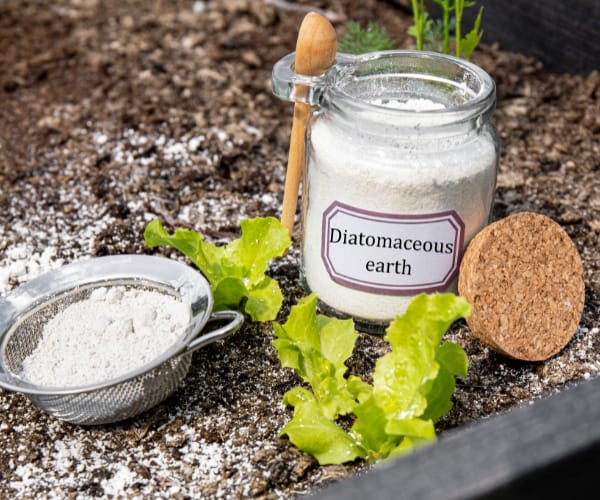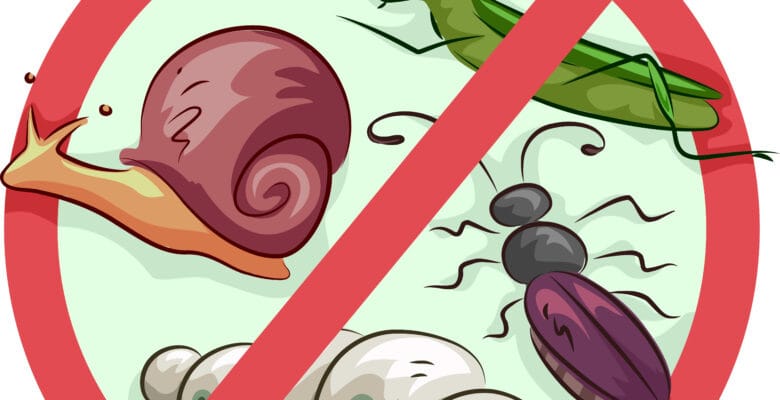Disclosure: This post may contain affiliate links, meaning we get a commission if you decide to make a purchase through our links, at no cost to you. See our full disclosure here.
Are you tired of sharing your harvest with unwanted guests? Are slugs, snails, and other creepy crawlies turning your lush garden into a buffet? It’s a common gardener’s dilemma, but there’s a natural and effective solution that’s been used for centuries: diatomaceous earth (DE). This post will explore the wonders of DE and how it can help you reclaim your garden, say goodbye to pests, and grow healthier, more vibrant plants.
DE is a staple in my garden supplies. I use it not only in the garden but also around the foundation of my house to help keep pests out. It is inexpensive, safe when properly used, and highly effective.
What is Diatomaceous Earth?
Diatomaceous earth isn’t actually “earth” in the traditional sense. It’s the fossilized remains of diatoms, which are microscopic, single-celled algae. These tiny organisms have intricate, silica-based shells. These shells accumulate and are mined when they die, creating the powder we know as diatomaceous earth. It’s important to note that there are different DE grades. For gardening, you should always use food-grade diatomaceous earth. Other grades, like filter grade, are used for industrial purposes and can be harmful. When used correctly, food-grade DE is safe for humans, pets, and the environment.

How Does Diatomaceous Earth Work Against Pests?
The magic of diatomaceous earth for healthier garden plants lies in its unique properties. The microscopic silica shells have incredibly sharp edges. When crawling insects, like slugs, snails, ants, or earwigs, come into contact with DE, these sharp edges pierce their exoskeletons. This causes tiny cuts and abrasions, leading to dehydration and, ultimately, death. Think of it like walking barefoot on broken glass–ouch!
While DE is very effective against crawling insects, it’s less effective against flying insects. It must also be reapplied after rain or watering, as it loses effectiveness when wet. A common concern is whether DE harms beneficial insects. When used correctly, the risk to beneficial insects like bees and ladybugs is minimal. Avoid applying DE directly to flowers or areas where pollinators are actively foraging.
Benefits of Using Diatomaceous Earth for Healthier Garden Plants
Beyond pest control, DE offers several other benefits for your garden:
- Soil Amendment: DE can improve soil drainage and aeration, especially in clay-heavy soils. Its porous structure helps retain moisture while preventing water logging.
- Nutrient Boost: DE contains trace minerals like silica, which can benefit plant growth and strengthen cell walls.
- Natural and Non-Toxic: Food-grade DE is a natural, non-toxic substance, making it a safe alternative to harsh chemical pesticides.
How to Use Diatomaceous Earth in Your Garden
There are several ways to apply DE in your garden:
- Dusting: Use a duster or your hands (wear gloves!) to lightly dust DE directly onto plants, especially the undersides of leaves, and the surrounding soil.
- Sprinkling: Sprinkle DE around the plants, creating a barrier that crawling insects must cross.
- Mixing with Water: While less effective for crawling insects, you can mix DE with water and spray it on plants. This method may be helpful for some soft-bodied pests like aphids, but reapplication is crucial.
Timing and Frequency: Apply DE when the weather is dry. Reapply after rain or watering to maintain its effectiveness.
Specific Pest Control Tips:
- Crawling Insects: Focus on applying DE to the soil and the base of plants.
- Ants: Locate ant trails and nests and apply DE directly to these areas.
- Slugs and Snails: Sprinkle DE around vulnerable plants, creating a ring they’re reluctant to cross.
Tips for Using Diatomaceous Earth for Healthier Garden Plants
- Always use food-grade DE.
- Wear a mask when applying DE, as the dust can irritate the lungs.
- Avoid applying DE when pollinators are active.
- Don’t over-apply. A little goes a long way.
Diatomaceous Earth vs. Other Pest Control Methods
Compared to chemical pesticides, DE is a much safer and more environmentally friendly option. While chemical pesticides can harm beneficial insects, wildlife, and even humans, DE poses minimal risk when used correctly. DE also complements other natural pest control methods, such as companion planting and introducing beneficial insects.
Conclusion
Using diatomaceous earth for healthier garden plants is a powerful tool for any gardener. DE helps provide a natural and effective way to manage pests and promote healthier plants. It’s a simple yet versatile solution that can help protect your garden and eliminate pests! So, ditch the harsh chemicals and give diatomaceous earth a try. Share your experiences with DE in the comments below–we’d love to hear how it works!
Disclaimer: This post is for informational purposes only and should not be construed as health, wellness or nutrition advice. Please see our full disclaimers here.


Leave a Reply